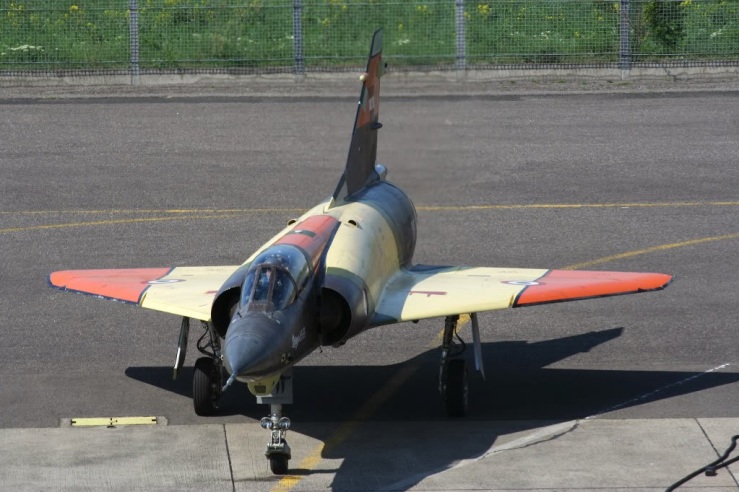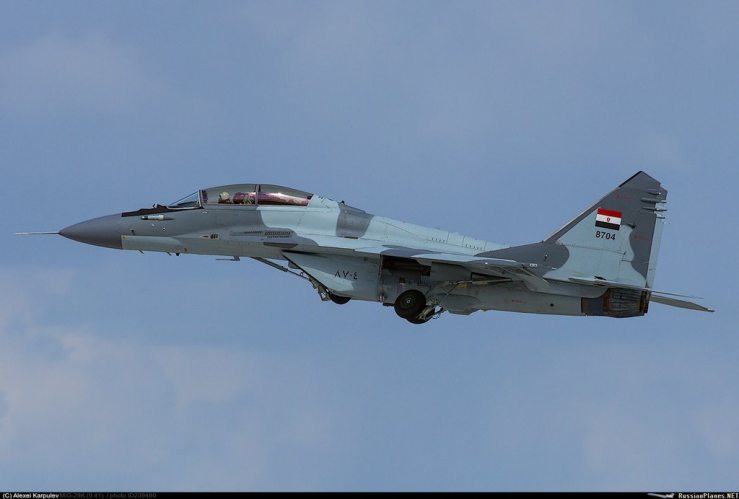Since the Peace Accords with Israel the Egyptian Air Force has gone through several changes. What was predominantly a Soviet equipped Air Force suddenly had to realign its procurement policies away from the Soviet Union and towards the West.
However it also had to keep several Soviet types such as the MiG – 21 in service as a stop-gap measure until it could induct newer, better, and most importantly supported fast jets after it cut relations with its former sponsor in favour of the United States. In order to help rebuild its Armed Forces $1.3 Billion of US government budget was allocated to Egypt for the past 40 odd years.
What was planned though did not happen what did is somewhat perplexing to the outside observer and angering to anyone who has heard of something called logistics. Without getting bogged down in the how or why of history or procurement processes for the sake of brevity and to avoid an increase in blood pressure, Egypt at the turn of the century was operating six different fast jets from four different sources not including light attack aircraft and advanced trainers (the latter two being another headache).

The backbone of the EAF past the year 2000 was around 200 Lockheed F – 16 Falcons of various Blocks. In addition to that rather large fleet they also operated dozens of Mikoyan MiG – 21, Chengdu F – 7, McDonell Douglas F – 4 Phantom II, Dassault Mirage V, and Dassault Mirage 2000 fighter jets. In total the EAF was operating over 400 fighter jets before 2012. So what’s wrong with that?
It’s hard to pick somewhere to begin given that the differences have consequences from the top down. We’ll start with training of technicians and pilots or anyone generally hands on with the air craft. Instead of training infrastructure for one or two similar types the Air Force had to support half a dozen, each with different standards, procedures, and techniques meaning that it would require a fair bit of retraining for conversion from one type to another which creates a force that is not very flexible to say the least. Career prospects would be limited to the type someone serves on as the Air Force itself will have very little incentive to retrain personnel.
The Egyptian Air Force has a very odd fixation with differentiating sources of armament. Although understandable through a political lens it makes less sense when they stop prioritising some of their most ‘secure’ platforms in favour of something completely different and usually less capable. To illustrate my point lets take the example of the Mirage in Egyptian service. They invested heavily in repair and overhaul facilities for no more than six squadrons of fighters that were due to be retired in fifteen years or less and even went as far as upgrading two squadrons of Mirage V in 2003 (a fighter at the fringe of the AF and currently held in tactical reserve with the proposition of them being sold to Lebanon) while neglecting the forces backbone that is set to remain in service until 2040 at least.

The same could be said of the MiG – 21 some of which were upgraded as recently as 2008! A fighter which is currently out of service after an excruciatingly long time in the Air Force’s ranks and one that reached obsolescence decades ago. The point I’m trying to get at is that eventually you come to a situation where in order to keep the air craft on the fringe going to support a frankly bloated squadron number you neglect the backbone of the Air Force and operate a mixture that is incredibly expensive to maintain as a whole in an Armed Forces low on funds.
A far larger problem is that doctrine and organisation was influenced by equipment rather than the other way round and as a result the Air Defence often had to pick up the slack for the Air Force.

Not putting your eggs in one basket is understandable however it is a double-edged sword. In an attempt to be sanction proof the EAF has repeatedly underachieved at becoming what it should be, a leading Air Force in the MENA region.
They’re underachieving not only because of the nightmares that operating several types brings but because of their inability to network all of them into a cohesive fighting force. Network-Centric warfare has gone from a pretty good idea to a buzzword in recent years however it is something that is essential and achievable.
The difficulty in networking all these different types essentially meant that Egypt in real terms operated several air forces at the same time and this is the mistake they seem to be making again with the introduction of the MiG – 35 and also presents another missed opportunity for the EAF to achieve its potential.

By 2020 the EAF is set to complete the process of retiring its aging aircraft including early F – 16 A/B, Mirage 2000, and Mirage V fighters jets with the MiG – 21, F – 7, and F -4 all being fully retired or placed in tactical reserve already. In what I had previously dubbed Air Force 2020 the EAF was set to field 200 odd F – 16s and 24 Rafale fighters, certainly nothing to scoff at given Egypt also operates a rather healthy number of E-2C AWAC platforms and what should have been the basis for an eventual forward-looking cutting edge force.
With that mix they could comfortably (and currently are) face immediate threats including operations in the Sinai, Libya, and potentially Iran or Ethiopia if push comes to shove. However, after they surprised everyone with the Rafale deal they took a step backwards with their approach to Russia for the MiG – 35. Many observers of the Egyptian Armed Forces modernisation process post 2011 thought that they had finally got the message with the acquisition of the Rafale, Gowinds, Ambassadors, and FREMM frigate. Egypt was finally moving towards a force predominantly armed with Western equipment as part of a larger network that also included communication and remote sensing satellites. Our predictions were soon shattered.

Now this is not a slight on the MiG – 35, I’m sure it’s an excellent fighter in its own right and will hopefully serve the EAF well but it does not stack up to the Rafale which is where the money should have gone. Not only because it is the better fighter but because it gave the EAF the ability to plug and play. It shares much with Egypt’s F – 16 such as the Paveway family of guided munitions, Recce pods, and above all can be networked with them, unlike the MiG. So why the Russian fighter?
It’s time to address two rather large elephants in the room. The United States and Israel. Ever since the Peace Treaty between the two the United States has been the guarantor of Israeli qualitative and quantitative superiority in the region and in order to ensure that it has restricted certain system sales to Egypt including advanced air to air missiles for their F – 16 such as the AIM – 120 and AIM – 9X. Now whether Egypt has done much to deserve certain restrictions being lifted is another matter for another already planned blog.
Egypt will always measure its capability against that of its neighbour not just because of their past and the current somewhat cold peace but because in realist terms they are the greatest conventional threat in the region and a competitor. Because the US restricts crucial equipment from the Egyptians they often look elsewhere to fill the gap, Russia is often there to lap up the spoils.
This leaves Egypt in the same position it was in almost ten years ago. Eventually the EAF will have to support two forces instead of one again and in doing so it ends neglecting the backbone in the F – 16 and not investing enough in the Rafale because funds are being diverted towards the MiG – 35.
Now, what I have just written isn’t exactly popular within the Egyptian social media bubble as a result of a “Armed Forces knows best” attitude towards critcism and often people who should know better purposefully misleading readers who are unfamilliar with the subject. I’ve written this to hopefully generate some discussion or inform people about a subject few are interested in or know about. As always take everything I write with a pinch of salt as I’m not inside the decision process and may be way off as a result even though I often like to think I’m never wrong.
In the end what we have here is a cautionary tale of lessons not being learned and past mistakes being repeated.


[…] Western arms. Making combat service support a relatively easier task than for other divisions which have a dizzying mix of Western and Eastern equipment. https://www.youtube.com/watch?v=fbJvUs_JD8E Much like SOF they train their own troops to a […]
LikeLike
[…] con los últimos AMRAAM AIM-120 y misiles AIM-9X de exportación debido a los Estados Unidos. deseo de preservar La superioridad militar de israel en la […]
LikeLike
[…] F-16 Mesir yang tak dilengkapi rudal AIM-120 AMRAAM dan AIM-9X Sidewinder terbaru karena keinginan AS untuk menjaga keunggulan militer Israel di wilayah […]
LikeLike
[…] F-16 Mesir yang tak dilengkapi rudal AIM-120 AMRAAM dan AIM-9X Sidewinder terbaru karena keinginan AS untuk menjaga keunggulan militer Israel di wilayah […]
LikeLike
[…] of events after more than three decades of purchasing only American-made fighter jets. It was also driven largely by the U.S. embargo put in place in 2013, after the Egyptian army’s removal of then-President […]
LikeLike